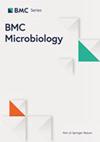Shima Afrasiabi, Fatemeh Saghatchi, Ahmad Reza Dehpour, Ramin Goudarzi, Mohammad Reza Karimi, Alireza Partoazar
下载PDF
{"title":"氢氧化锌纳米片抗变形链球菌的生物相容性和光失活评价。","authors":"Shima Afrasiabi, Fatemeh Saghatchi, Ahmad Reza Dehpour, Ramin Goudarzi, Mohammad Reza Karimi, Alireza Partoazar","doi":"10.1186/s12866-025-03822-x","DOIUrl":null,"url":null,"abstract":"<p><strong>Background: </strong>Considering the efficacy of antimicrobial photodynamic therapy (PDT) in inactivating bacteria, this study reports that zinc hydroxide chloride nanosheets (ZHC-NSs) are useful for this purpose.</p><p><strong>Materials & methods: </strong>The characterization of ZHC-NSs was performed using microscopic and spectroscopic techniques. The irritation test, acute toxicity test, and genotoxicity test of ZHC-NSs were evaluated and their effects on human pulp fibroblast cells (HPFC) viability, intracellular reactive oxygen species (ROS) levels, and antibacterial activity of ZHC-NSs (1-8 mg ml<sup>-1</sup>) alone or in light conditions were investigated.</p><p><strong>Results: </strong>The ZHC-NSs structure showed a crystalline form and their sheets' thickness had an average size of 129.6 ± 19.50 nm. ZHC-NSs did not severely damage internal organs and were not genotoxic. The cytotoxic effect of ZHC-NSs on HPFC was concentration-dependent so that ZHC-NSs at higher concentrations (4 and 8 mg ml<sup>-1</sup>) killed half of the HPFC cells. When ZHC-NSs were used in combination with a 980 nm diode laser, namely ZHC-NS<sup>©</sup>, ROS production increased and led to enhanced antibacterial activity against Streptococcus mutans in planktonic and biofilm form. A statistically significant difference was found between ZHC-NSs without laser irradiation and photoexcited ZHC-NSs.</p><p><strong>Conclusion: </strong>ZHC-NSs<sup>©</sup> with the potential ability to produce ROS could be effective in complementary treatment against S. mutans.</p>","PeriodicalId":9233,"journal":{"name":"BMC Microbiology","volume":"25 1","pages":"116"},"PeriodicalIF":4.0000,"publicationDate":"2025-03-04","publicationTypes":"Journal Article","fieldsOfStudy":null,"isOpenAccess":false,"openAccessPdf":"https://www.ncbi.nlm.nih.gov/pmc/articles/PMC11877797/pdf/","citationCount":"0","resultStr":"{\"title\":\"Biocompatibility and photoinactivation evaluation of zinc hydroxide chloride nanosheets against Streptococcus mutans.\",\"authors\":\"Shima Afrasiabi, Fatemeh Saghatchi, Ahmad Reza Dehpour, Ramin Goudarzi, Mohammad Reza Karimi, Alireza Partoazar\",\"doi\":\"10.1186/s12866-025-03822-x\",\"DOIUrl\":null,\"url\":null,\"abstract\":\"<p><strong>Background: </strong>Considering the efficacy of antimicrobial photodynamic therapy (PDT) in inactivating bacteria, this study reports that zinc hydroxide chloride nanosheets (ZHC-NSs) are useful for this purpose.</p><p><strong>Materials & methods: </strong>The characterization of ZHC-NSs was performed using microscopic and spectroscopic techniques. The irritation test, acute toxicity test, and genotoxicity test of ZHC-NSs were evaluated and their effects on human pulp fibroblast cells (HPFC) viability, intracellular reactive oxygen species (ROS) levels, and antibacterial activity of ZHC-NSs (1-8 mg ml<sup>-1</sup>) alone or in light conditions were investigated.</p><p><strong>Results: </strong>The ZHC-NSs structure showed a crystalline form and their sheets' thickness had an average size of 129.6 ± 19.50 nm. ZHC-NSs did not severely damage internal organs and were not genotoxic. The cytotoxic effect of ZHC-NSs on HPFC was concentration-dependent so that ZHC-NSs at higher concentrations (4 and 8 mg ml<sup>-1</sup>) killed half of the HPFC cells. When ZHC-NSs were used in combination with a 980 nm diode laser, namely ZHC-NS<sup>©</sup>, ROS production increased and led to enhanced antibacterial activity against Streptococcus mutans in planktonic and biofilm form. A statistically significant difference was found between ZHC-NSs without laser irradiation and photoexcited ZHC-NSs.</p><p><strong>Conclusion: </strong>ZHC-NSs<sup>©</sup> with the potential ability to produce ROS could be effective in complementary treatment against S. mutans.</p>\",\"PeriodicalId\":9233,\"journal\":{\"name\":\"BMC Microbiology\",\"volume\":\"25 1\",\"pages\":\"116\"},\"PeriodicalIF\":4.0000,\"publicationDate\":\"2025-03-04\",\"publicationTypes\":\"Journal Article\",\"fieldsOfStudy\":null,\"isOpenAccess\":false,\"openAccessPdf\":\"https://www.ncbi.nlm.nih.gov/pmc/articles/PMC11877797/pdf/\",\"citationCount\":\"0\",\"resultStr\":null,\"platform\":\"Semanticscholar\",\"paperid\":null,\"PeriodicalName\":\"BMC Microbiology\",\"FirstCategoryId\":\"99\",\"ListUrlMain\":\"https://doi.org/10.1186/s12866-025-03822-x\",\"RegionNum\":2,\"RegionCategory\":\"生物学\",\"ArticlePicture\":[],\"TitleCN\":null,\"AbstractTextCN\":null,\"PMCID\":null,\"EPubDate\":\"\",\"PubModel\":\"\",\"JCR\":\"Q2\",\"JCRName\":\"MICROBIOLOGY\",\"Score\":null,\"Total\":0}","platform":"Semanticscholar","paperid":null,"PeriodicalName":"BMC Microbiology","FirstCategoryId":"99","ListUrlMain":"https://doi.org/10.1186/s12866-025-03822-x","RegionNum":2,"RegionCategory":"生物学","ArticlePicture":[],"TitleCN":null,"AbstractTextCN":null,"PMCID":null,"EPubDate":"","PubModel":"","JCR":"Q2","JCRName":"MICROBIOLOGY","Score":null,"Total":0}
引用次数: 0
引用
批量引用

 求助内容:
求助内容: 应助结果提醒方式:
应助结果提醒方式:


